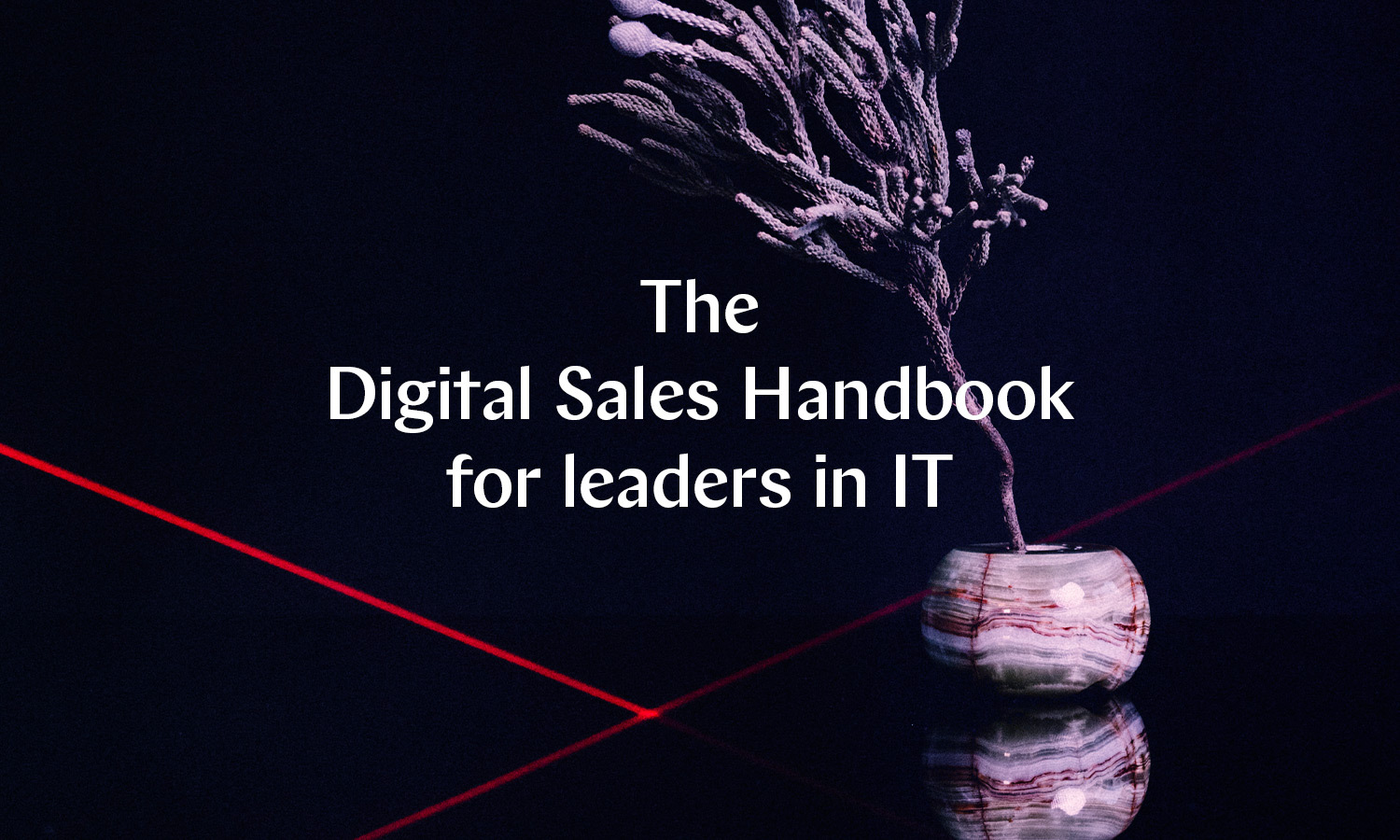The Data Handbook
How to use data to improve your customer journey and get better business outcomes in digital sales. Interviews, use cases, and deep-dives.
Get the book
How can we naturally integrate sales as an essential part of IT? The organisational set up can be fashioned in several different ways. There is no one size fits all. And in the end, what matters is not how it is done but that it is done. Successful integration happens when you think it through and then do something to make it a reality. It will not happen by itself.
|
This blog is part of our book: The Digital Sales Handbook for leaders in IT. Be sure to claim your own free copy of the book. Author introductions: Elli Pyykkö, Digital Sales Strategist and Seasoned Project Lead Juho Jutila, Mastermind Strategist and Architect |
As a company grows, it tends to centralise and control things. We’ve also seen cases where ecommerce is a standalone unit that does its own thing — just like sales and marketing.
So, when considering your ecommerce team, should the team itself fall under sales? What about marketing? IT? A separate digital organisation?
Well, there is no correct answer. It’s more important that the set-up is considered and that the decision is made consciously in the current circumstances.
Take, for example, an ecommerce team under the marketing umbrella. In actuality, the team will need to be liaising with IT and with sales, even though they’re officially in a marketing role. The same goes for an ecommerce team under the IT umbrella — that team will need to liaise regularly with marketing colleagues and sales colleagues.
Digital sales should comprise several components to work optimally and efficiently:
- Marketing for driving traffic and generating awareness — in ecommerce, marketing can almost be considered practically the same as sales
- Data & analytics to learn how visitors are behaving and how conversions are working
- IT to optimise the conversions in the web shop (or other digital interfaces), keep the platforms running and backed up as well as to suggest and deploy new possibilities and solutions available through technology
- Service & offering design to optimise “the what” and “the how” of what is being sold — typically one ecommerce storefront includes products from all business lines
- Sales to provide targets and coordinate activities and metrics with other sales channels
All of these functions need to work together in one way or another.
Collaborative contact > single unit running the show
Collaborative communication is crucial. There will always be conflicts. Without communication, there is no way to settle those conflicts. And we’ve seen these conflicts time and time again when any single business unit takes the lead and does not consider how the goals of different stakeholders play together.
Marketing may feel that IT is doing something that’s on marketing’s territory and IT might be thinking, “Hey, this is getting out of our control. Sales leaders are now acquiring systems that don’t work or haven’t been vetted by us — and we’re the ones that need to maintain them.” There needs to be genuine coherence to have everyone on board.
As we’ve been advising our own clients, the ultimate goal is generating sales and revenue. It needs to be the north star metric that everything else serves. And as that begins to take shape, build around that progression.
Competent IT leadership is crucial to long-term success
It’s okay to push forward and pursue increments that are not so scalable in the beginning. However, there needs to also be a strategic plan for how you organise and set up when the beginning isn’t the new thing anymore.
For IT and its leaders to play a vital role in digital sales, they must provide enough competence and capabilities for the environments, tools, and platforms that are chosen to support fast-moving digital commerce.
“If a digital sales team plans to A/B test their web shop or they want to fast track new feature development for their extranet, IT shouldn’t stand in the way or insist on long processes.”
— Juho Jutila
Whether it’s a B2C web shop, a B2B marketing automation system or some sort of customer portal, the minimal role of IT is to keep the platform running smoothly, ensuring the best security and privacy practices. At the same time, IT needs to provide the organisation with the means to develop these capabilities in an agile manner at a rapid pace. It goes beyond agile, too. Our approach to operating digital sales is combining agile, continuous experimentation, cross-functional teams and business ownership. In addition, while the agile methodology typically only involves developers and designers, we want marketers and sales teams fully on board and involved.
If a digital sales team plans to A/B test their web shop or they want to fast track new feature development for their extranet, IT shouldn’t stand in the way or insist on long processes. Instead, they should help and facilitate using agile development methods and growth hacking practices. Develop the solution and test it as development moves along in sprints.
The question for IT is: When can a solution in a test phase be considered a permanent building block of solution architecture? What are the governance architecture requirements imposed for a test phase solution versus a permanent solution?
So, whether the ecommerce organisation is within IT or elsewhere, IT must be able to provide that kind of certainty and service to keep the engine running while still developing new solutions in basically two modes: agile new core functionality development and testing and experimenting with new iterations in a growth hacking mode.
Sales targets for IT? Hell yes!
We have seen it many times with clients. When bigger enterprises scale, frequently IT will have a solution owner. Then there is a sales or marketing counterpart in a business owner role making decisions for a webstore or marketing automation system.
Unfortunately, there are seldom sales targets from the IT side that drive revenue-focused development. Instead, IT will usually have traditional IT targets: platform availability, critical incident numbers, ticket response time, and before everything else — cost. Where’s the upside? Where’s the customer experience that makes customers fall in love with your product?
A CIO must ensure that relevant IT people have sales targets that are put into IT budgets. People have talked about IT being only a cost and recognised a need to get out of this mindset. Target setting is the natural way to become a revenue-generating business and a new business enabler. Ask the question, “What is the impact on stakeholder metrics?”
In this way, when IT comes up with a development initiative to drive conversions from something that exists in the marketing matrix, IT should of course be rewarded for it. Behaviour and performance = reward. Does this ring a bell? It should, but it gets forgotten in IT far too often.
This goes back to putting together that cross-functional growth team, which will drive conversions. And here you have people from IT, from marketing, from sales and other experts like analysts and data scientists.
“All throughout, this whole team is collaborating, generating new ideas, new solutions and working together as one, cohesive agile team.” — Elli Pyykkö
As this team collaborates, usually a growth owner is nominated to drive the team. While this person could come from anywhere, they usually come from sales — because if a growth owner would be someone from IT, then IT would actually be the business. This could be a hard pill to swallow for some, considering that IT is the enabler for the business.
All throughout, this whole team is collaborating, generating new ideas, new solutions and working together as one, cohesive agile team.
There’s inertia to change. The value needs to be proven fast.
Unfortunately, we see quite a lot of hesitation when it comes to suggesting a sales-enabling way of working in IT.
Sure, clients will want to give this agile and growth hacking combo a shot, but as they consider what they’re used to, fear sets in when thinking of the speed involved. Many times, IT will actually try to slow things down. A lot of hand-holding is needed to shift towards a new way of thinking.
So even when a company may say they are moving forward with super-fast agile development, the decision-making processes are sometimes still not smooth despite having a set of agile principles followed on paper. It is contradictory and kills any good initiative that might be floating around.
We’d be naïve to think there aren’t other factors within a company that will hinder real benefits and experimentation from happening. For example, leaders still talk about “projects” — in the sense of, say, an ecommerce project that will start and end. Instead, it should be conceived as something that continues to evolve and is constantly optimised — just as a traditional store is operated.
We see this mindset is still very much in a transitional phase.
Embrace change or assume a defensive posture
Let's consider retail for a moment. Retailers have had ecommerce platforms up and running for years, and they are starting to discover best practices for operating those. Still, many retailers are struggling to properly implement truly cross-functional teams who have concrete business ownership of their specific area in their ecommerce setup.
We’re seeing the change happening much slower on the B2B side. In industrial manufacturing and traditional B2B commerce, sales are more focused on creating trust-based relationships with longer-term customers. Something you sell may be worth tens of millions of euros. The thinking is typically something like this: “We don’t even need digital sales. We just need good salespeople to create trust and nurture those relationships.” Pharmaceuticals is another case of a slower-moving industry which needs to factor in regulatory controls that affect their pace and ways of working.
Of course, there are plenty of B2B companies that are far ahead of the game. They have a fully up-to-speed, sales-enabling IT doing quite well — and reap the benefits.
Thinking outside the box, and the silos
The common denominator here isn’t a specific industry or company size.
The one real difference-maker? Outspoken leaders from sales on the forefront insisting on moving towards a digital sales mindset. This, combined with a supportive IT holding tangible sales targets, has brought the most success for those businesses, regardless of their size or industry.
When the responsibilities and targets are channel-specific, then the organisational setup creates internal competition. It creates friction in offering omnichannel marketing and shopping experiences.
In successful companies with the most impressive ecommerce solutions, the ecommerce channel isn’t run alone within a silo. It is again a question of digital sales coming together with IT, with marketing, with service design, analytics, all product lines and so on.
While it may seem old hat in 2021 to say, “We need to break down the silos,” ecommerce is the ultimate example of this need. It does not mean giving up the division of labour or forgetting specialisation. Remember the statement about giving IT sales targets? That’s how you free bright people to think and collaborate outside their usual routines.
This blog post is part of the Digital Sales Handbook for leaders in IT. The Handbook is a crystallisation of the key themes leaders in IT need to understand in 2021 to push their digital-enabled sales forward. The book includes interviews with industry experts from companies including Stora Enso, SAS, UPM and Tiger of Sweden. Learn how your IT can become an active driver for digital sales!
The Data Handbook
How to use data to improve your customer journey and get better business outcomes in digital sales. Interviews, use cases, and deep-dives.
Get the book




